|
THERE are, of course, many ways to travel Thailand, but the best, I would argue, is a behind-the-scenes hands-on trip through its cuisine. Which is why I found myself beginning a recent trip to the kingdom at the Cooking School of the Oriental, the legendary luxury hotel on the Chao Praya River in the heart of Bangkok where Chef Sarnsern Gajaseni holds his classes.
Chef Gajaseni (or Phae, his nickname) opens with a simple recipe: fried rice. He explains the strange concept of eating with our hands � �Small amounts of rice� � and what oils to use: �Never olive, and only very little sesame oil, that�s a seasoning; use palm or soybean, but lard is best, oil from pig fat.� Only use long grain rice, not jasmine, he says. �And it has to be leftover from yesterday. Heat the oil, add some �nam pla� (literally �water fish�, the famous sauce of fermented anchovies), and stir fast. That�s it!� 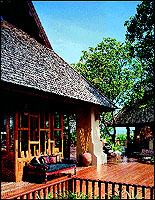 Then he turns to our centerpiece today, the most important dish in Thailand: Thai curry. �Which isn�t,� says Phae forcefully, �curry at all. It�s really chili. �Curry� is the word that�s used, but remember: the foundation of every Thai curry is a terrific chili paste.� �There are two major chili pastes,� says Phae, �red and green. If you mix them, you get brown, called �massaman� curry, thick, with peanuts, meat, and potatoes, but that�s not Thai, it�s really Indian � the Indians came as spice traders and adapted massaman to their taste. In the south you can get curries with yellow chilis and turmeric, but that�s actually Malay. So let�s study real Thai curries.
Then he turns to our centerpiece today, the most important dish in Thailand: Thai curry. �Which isn�t,� says Phae forcefully, �curry at all. It�s really chili. �Curry� is the word that�s used, but remember: the foundation of every Thai curry is a terrific chili paste.� �There are two major chili pastes,� says Phae, �red and green. If you mix them, you get brown, called �massaman� curry, thick, with peanuts, meat, and potatoes, but that�s not Thai, it�s really Indian � the Indians came as spice traders and adapted massaman to their taste. In the south you can get curries with yellow chilis and turmeric, but that�s actually Malay. So let�s study real Thai curries.
�Here�s the recipe for red curry paste,� says Phae. �Nine dried red serrano chilis. They�re quite big, see?� He holds them up. �Cut them open and deseed. The real strength of the chilis is in the white membrane holding the seeds, not, as most people think, in the seeds themselves. Soak them in warm water for 20 minutes; never use them dry. Next: seven cloves of garlic. Five shallots with small heads. One stalk of lemongrass, only the bottom five or six inches. Galanga, which is Thai ginger �five slices the size and thickness of a quarter. One tablespoon of coarsely chopped kaffir lime peel. One big coriander root. Don�t use the leaves, that�s cilantro. Ground white pepper, one teaspoon � Thai never use black pepper, only white. And one teaspoon shrimp paste. Grind to a paste with a mortar and pestle.� 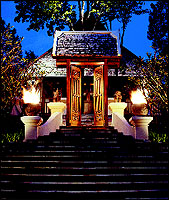 And green curry? Exactly the same, says Phae, except instead of nine red serranos, use 27 of the tiny fresh green birdseye chilis. Don�t deseed the green chilis. You can also freeze the paste. Two or three tablespoons makes curry for eight people. And, you can freshen up commercial paste by adding small amounts of fresh ingredients.
And green curry? Exactly the same, says Phae, except instead of nine red serranos, use 27 of the tiny fresh green birdseye chilis. Don�t deseed the green chilis. You can also freeze the paste. Two or three tablespoons makes curry for eight people. And, you can freshen up commercial paste by adding small amounts of fresh ingredients.
We move to the kitchen, and Phae then teaches us the rest of the recipe as he makes the curry: He boils 5 cups coconut milk in a wok, throws in the chili paste, and lets it boil furiously till oil starts forming on top. �Fry the paste in reduced thick coconut milk till the oil seeps out,� he says, �that�s the secret.� Then he puts in whole shrimp (�If you want to use fish,� he says, �use catfish with the skin on�), soy sauce, palm sugar, fresh Thai basil and kaffir leaves, pea eggplant, and fresh bamboo shoots. He dumps in a nice handful of sliced red chilis. �The other secret,� says Phae, �is that you should always age curry 2-3 hours or more at room temperature. In Thailand, we try to make it one day ahead, then we bring it to a boil the next day and serve it at room temperature. 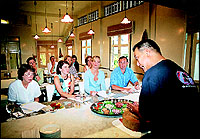 A few days and a flight to the north later, I walk up the gracefully curved stone steps leading to the teak gate of the Cooking School at the Four Seasons Chiang Mai. This, it turns out, is completely different from the Oriental�s. Here it�s all about hands-on: We move to our stations and, after demonstrations from our chef-instructor, Pitak (�Pok�), gentle and methodical, we start flinging ingredients into our woks, dropping wrappings in hot oil, stir frying spring onions and cabbage and shrimp. We make �krathong thong� (pork and shrimp tartlets) and �kung sa rong,� deep-fried crispy egg noodle-wrapped prawns; I use palm sugar, golden brown and deliciously fragrant, for my dipping sauce instead of white, and everyone agrees it tastes better. By the time the class ends, at around 1 p.m., we are all so sated we can barely move. We receive our diplomas in a stupor and wander off to the Four Seasons� pool.
A few days and a flight to the north later, I walk up the gracefully curved stone steps leading to the teak gate of the Cooking School at the Four Seasons Chiang Mai. This, it turns out, is completely different from the Oriental�s. Here it�s all about hands-on: We move to our stations and, after demonstrations from our chef-instructor, Pitak (�Pok�), gentle and methodical, we start flinging ingredients into our woks, dropping wrappings in hot oil, stir frying spring onions and cabbage and shrimp. We make �krathong thong� (pork and shrimp tartlets) and �kung sa rong,� deep-fried crispy egg noodle-wrapped prawns; I use palm sugar, golden brown and deliciously fragrant, for my dipping sauce instead of white, and everyone agrees it tastes better. By the time the class ends, at around 1 p.m., we are all so sated we can barely move. We receive our diplomas in a stupor and wander off to the Four Seasons� pool.
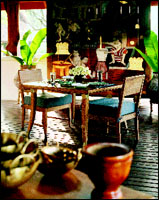 I fly back to Bangkok. Next morning I arrive at the Shangri-La Hotel. Once again, a marked difference. I make everything with the chef, Wiwat, and we make a full three-course meal. We start with �poh pia jae thord,� deep fried spring rolls with mixed vegetables: white cabbage, taro, Chinese mushrooms, celery. We wrap the vegetables in thin pancakes, fry to a golden brown, and dip in a sweet and sour sauce with red chilis. Wiwat�s prawn green curry is simpler than Phae�s but no less delicious. And then we do a dessert: �woon kati,� literally �jelly, coconut cream.� It�s incredibly simple: Take out the juice and meat of one young coconut; mix the juice with 30 gr jelly powder and 100 gr coconut milk, 50 gr sugar and 5 gr salt; mix, then boil 5 minutes with the coconut meat; pour into a mold and set 30 minutes in the fridge.
I fly back to Bangkok. Next morning I arrive at the Shangri-La Hotel. Once again, a marked difference. I make everything with the chef, Wiwat, and we make a full three-course meal. We start with �poh pia jae thord,� deep fried spring rolls with mixed vegetables: white cabbage, taro, Chinese mushrooms, celery. We wrap the vegetables in thin pancakes, fry to a golden brown, and dip in a sweet and sour sauce with red chilis. Wiwat�s prawn green curry is simpler than Phae�s but no less delicious. And then we do a dessert: �woon kati,� literally �jelly, coconut cream.� It�s incredibly simple: Take out the juice and meat of one young coconut; mix the juice with 30 gr jelly powder and 100 gr coconut milk, 50 gr sugar and 5 gr salt; mix, then boil 5 minutes with the coconut meat; pour into a mold and set 30 minutes in the fridge.
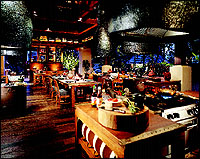 Thai Cooking Schools
Thai Cooking Schools
Practical Information
The Cooking School at Four Seasons Chiang Mai
You can contact
Four Seasons Chiang Mai at:
Mae Rim-Samoeng Old Road,
Mae Rim, Chiang Mai 50180
Thailand. Tel 66 (53) 298 181
Or by writing to the Four Seasons Chiang Mai via
https://secure.fourseasons.com/secure/contact_us/information_requests.html
The cooking school's information is nicely and clearly resumed on a single web page:
www.fourseasons.com/chiangmai/vacations/special_features.html
Guest can reserve the class through the Reservation Number 66-53-29818, and they also have a special package available, which can be reserved via the web:
www.fourseasons.com/apps/amadeus/index.weml?propertyID=147&segment=vacations
Classes are held Monday through Saturday from 9 a.m. - 1 p.m. in all seasons. All classes are conducted in English, and recipes are printed and given to students. Classes cost US$85.00 for the one-day single class. The optional market trip in the early morning costs US$35.00 extra.
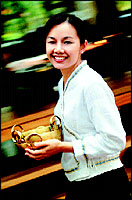
The Thai Cooking School at the Oriental Hotel Bangkok
You can contact
The Oriental Bangkok at:
48 Oriental Avenue
Bangkok 10500
Tel 66 (0) 2659 9000
Fax: +66 2 659 0000
Guests can book conveniently and directly with the Thai Cooking School on Tel: +66 2 437 6211 / Fax: +66 2 439 7587 or at the hotel main number. The contact person at the Thai Cooking School is Ms Tanika Peerakum, and her email is [email protected] or [email protected].
The Oriental Thai Cooking School operates every Monday to Saturday for both in house and outside guests from 9 a.m. to 12 noon. Classes are conducted in English and are limited to 15 persons. Classes run all year long. Recipes are nicely printed and given out. There are demonstration classes (students watch the chef) Monday to Thursday:
Monday Introduction, ingredients, snacks and salads.
Tuesday Soups, desserts, fruit vegetable carvings.
Wednesday Curries, condiments, and side dishes.
Thursday Steam, stir fry, fry and grilled dishes.
Friday and Saturday are "Hands on" Cooking Classes with dishes rotating on a four month basis. Guests watch the preparation of their favourite dishes and then make them immediately.
Friday: Noodles, curries, snacks.
Saturday: Stir-fry, soups, salads.
Classes, in English, cost US$ 120 per person per class. Classes created by special arrangement to be conducted in other languages cost US$ 150 per person per class. Lunch is included with classes on Monday, Wednesday, and Thursday.
There is also a Thai Cooking School 5 night/6 day package that can be booked from the website: www.mandarin-oriental.com/bangkok/
The package includes the following: limousine transfer to and from Bangkok International Airport; welcome dinner at The Sala Rim Naam Restaurant; 60 minutes jet lag massage at The Oriental Spa; four day course (Monday - Thursday 9 a.m. to 12 noon daily) by renowned Thai chef instructors with comprehensive instruction materials and all required classroom ingredients; five nights accommodation in Superior Room; River Wing buffet breakfast at The Verandah; Monday to Friday post Classroom luncheon - Monday, Wednesday and Thursday
l Single occupancy
S$ 1,600 net per room
l Double occupancy
US$ 2,200 net per room
The Cooking School at the Shangri-La Hotel Bangkok
You can contact the Shangri-La Hotel Bangkok at:
89 Soi Wat Suan Plu, New Road, Bangrak, Bangkok 10500
(66 2) 236 7777
Fax: (66-2) 236 8579
Email: [email protected]
Guests can book cooking classes directly at [email protected]. You can also book by phone by calling the Salathip Restaurant (66 2) 236 9952 or 7777. Their fax is (66 2) 237 3688 or (66 2)236 8579.
The Cooking School at the Shangri-La offers classes every day of the week and must be booked one day in advance. Students leave early by bus to the famous Chatuchak market in Bangkok to learn about Thai fruits, meats, vegetables, and spices, then return to the hotel for hands-on cooking classes. Classes are held in the Salathip Thai Restaurant's teak pavillion overlooking the Chao Praya River, usually ending at 12 noon, and recipes are given to each student. Each class ends with a luncheon of the food you've prepared.
Classes cost 1,950 Thai Baht per person.
|



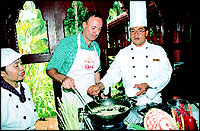 Wok�s Cooking In Bangkok?
Wok�s Cooking In Bangkok?

 Then he turns to our centerpiece today, the most important dish in Thailand: Thai curry. �Which isn�t,� says Phae forcefully, �curry at all. It�s really chili. �Curry� is the word that�s used, but remember: the foundation of every Thai curry is a terrific chili paste.� �There are two major chili pastes,� says Phae, �red and green. If you mix them, you get brown, called �massaman� curry, thick, with peanuts, meat, and potatoes, but that�s not Thai, it�s really Indian � the Indians came as spice traders and adapted massaman to their taste. In the south you can get curries with yellow chilis and turmeric, but that�s actually Malay. So let�s study real Thai curries.
Then he turns to our centerpiece today, the most important dish in Thailand: Thai curry. �Which isn�t,� says Phae forcefully, �curry at all. It�s really chili. �Curry� is the word that�s used, but remember: the foundation of every Thai curry is a terrific chili paste.� �There are two major chili pastes,� says Phae, �red and green. If you mix them, you get brown, called �massaman� curry, thick, with peanuts, meat, and potatoes, but that�s not Thai, it�s really Indian � the Indians came as spice traders and adapted massaman to their taste. In the south you can get curries with yellow chilis and turmeric, but that�s actually Malay. So let�s study real Thai curries. And green curry? Exactly the same, says Phae, except instead of nine red serranos, use 27 of the tiny fresh green birdseye chilis. Don�t deseed the green chilis. You can also freeze the paste. Two or three tablespoons makes curry for eight people. And, you can freshen up commercial paste by adding small amounts of fresh ingredients.
And green curry? Exactly the same, says Phae, except instead of nine red serranos, use 27 of the tiny fresh green birdseye chilis. Don�t deseed the green chilis. You can also freeze the paste. Two or three tablespoons makes curry for eight people. And, you can freshen up commercial paste by adding small amounts of fresh ingredients.  A few days and a flight to the north later, I walk up the gracefully curved stone steps leading to the teak gate of the Cooking School at the Four Seasons Chiang Mai. This, it turns out, is completely different from the Oriental�s. Here it�s all about hands-on: We move to our stations and, after demonstrations from our chef-instructor, Pitak (�Pok�), gentle and methodical, we start flinging ingredients into our woks, dropping wrappings in hot oil, stir frying spring onions and cabbage and shrimp. We make �krathong thong� (pork and shrimp tartlets) and �kung sa rong,� deep-fried crispy egg noodle-wrapped prawns; I use palm sugar, golden brown and deliciously fragrant, for my dipping sauce instead of white, and everyone agrees it tastes better. By the time the class ends, at around 1 p.m., we are all so sated we can barely move. We receive our diplomas in a stupor and wander off to the Four Seasons� pool.
A few days and a flight to the north later, I walk up the gracefully curved stone steps leading to the teak gate of the Cooking School at the Four Seasons Chiang Mai. This, it turns out, is completely different from the Oriental�s. Here it�s all about hands-on: We move to our stations and, after demonstrations from our chef-instructor, Pitak (�Pok�), gentle and methodical, we start flinging ingredients into our woks, dropping wrappings in hot oil, stir frying spring onions and cabbage and shrimp. We make �krathong thong� (pork and shrimp tartlets) and �kung sa rong,� deep-fried crispy egg noodle-wrapped prawns; I use palm sugar, golden brown and deliciously fragrant, for my dipping sauce instead of white, and everyone agrees it tastes better. By the time the class ends, at around 1 p.m., we are all so sated we can barely move. We receive our diplomas in a stupor and wander off to the Four Seasons� pool. I fly back to Bangkok. Next morning I arrive at the Shangri-La Hotel. Once again, a marked difference. I make everything with the chef, Wiwat, and we make a full three-course meal. We start with �poh pia jae thord,� deep fried spring rolls with mixed vegetables: white cabbage, taro, Chinese mushrooms, celery. We wrap the vegetables in thin pancakes, fry to a golden brown, and dip in a sweet and sour sauce with red chilis. Wiwat�s prawn green curry is simpler than Phae�s but no less delicious. And then we do a dessert: �woon kati,� literally �jelly, coconut cream.� It�s incredibly simple: Take out the juice and meat of one young coconut; mix the juice with 30 gr jelly powder and 100 gr coconut milk, 50 gr sugar and 5 gr salt; mix, then boil 5 minutes with the coconut meat; pour into a mold and set 30 minutes in the fridge.
I fly back to Bangkok. Next morning I arrive at the Shangri-La Hotel. Once again, a marked difference. I make everything with the chef, Wiwat, and we make a full three-course meal. We start with �poh pia jae thord,� deep fried spring rolls with mixed vegetables: white cabbage, taro, Chinese mushrooms, celery. We wrap the vegetables in thin pancakes, fry to a golden brown, and dip in a sweet and sour sauce with red chilis. Wiwat�s prawn green curry is simpler than Phae�s but no less delicious. And then we do a dessert: �woon kati,� literally �jelly, coconut cream.� It�s incredibly simple: Take out the juice and meat of one young coconut; mix the juice with 30 gr jelly powder and 100 gr coconut milk, 50 gr sugar and 5 gr salt; mix, then boil 5 minutes with the coconut meat; pour into a mold and set 30 minutes in the fridge.
 Thai Cooking Schools
Thai Cooking Schools